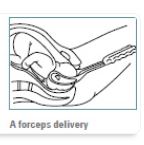Assisted vaginal birth
What is an assisted birth?
An assisted birth means that an obstetrician uses specially designed instruments, such as vacuum cup (ventouse) or forceps, to help your baby to be born.
Why did I need an assisted birth?
There are many reasons for needing an assisted birth such as:
- your baby’s heart rate suggests they may no longer be coping with the labour process
- your baby is not moving through the birth canal despite pushing
- for other reasons (sometimes medical) an unassisted delivery was not possible.
What procedures happen before an assisted birth?
Before your assisted birth, your obstetrician checked to make sure that your baby could be safely birthed vaginally. This involved examining your abdomen and performing an internal vaginal examination to check the position of your baby’s head in your vagina.
You would usually be given pain relief during an assisted birth. This would either be as a local anaesthetic injection inside the vagina or a regional anaesthetic injection given into the space around the nerves in your back (an epidural or a spinal). Your bladder may have been be emptied using a small tube called a catheter. Occasionally the obstetrician may be so worried about your baby they may have limited time to wait for the pain relief they would ideally like to provide for you—this would have been discussed with you at the time.
What happens with a vacuum delivery?
.JPG)
Ventouse (or vacuum extractor) is an instrument that uses suction to attach a plastic cup onto your baby’s head. The cup is attached to a suction device which enables the suction cup to become firmly applied to your baby’s head.
With a contraction, and while you are pushing, the obstetrician gently pulls to help deliver your baby. A vacuum can help with turning your baby when their head is not in the best position for birth.
What happens with a forceps delivery?
 Forceps are metal instruments that look like large curved spoons which fit around your baby’s head. The forceps are carefully positioned around your baby’s head and joined together at the handles. With a contraction, and while you are pushing, the obstetrician gently pulls to help deliver your baby. There are many different types of forceps and the obstetrician will choose the type of forceps which are most appropriate for each woman and her baby.
Forceps are metal instruments that look like large curved spoons which fit around your baby’s head. The forceps are carefully positioned around your baby’s head and joined together at the handles. With a contraction, and while you are pushing, the obstetrician gently pulls to help deliver your baby. There are many different types of forceps and the obstetrician will choose the type of forceps which are most appropriate for each woman and her baby.
What happened when my baby was born?

As your baby was being born, a cut (episiotomy) may have been made to enlarge your vaginal opening. If you had a vaginal tear or cut, this would usually have been repaired with stitches which will dissolve over a few weeks. Ice-packs, firm support and rest will help during the recovery process.
The neonatal (baby) doctors will be present for all assisted births and would have checked your baby soon after birth to see if they needed any help with breathing and to ensure they are healthy.
The vacuum cup can leave a temporary swelling on your baby’s head called a ‘chignon’. It may also cause some bleeding (like a bruise) between the layers of membranes on your baby’s head. This is called a ‘caput’ if it lies just under the skin and a ‘cephalhaematoma’ if it lies between the membrane covering one of the bones of the skull and the bone itself. Caputs and cephalhaematomas resolve spontaneously over several weeks and generally need no treatment or only some paracetamol in the first few days. Your baby is more likely to become jaundiced if there is a large caput or cephalhaematoma. As cephalhaematomas start to go away, you can often feel a firm rim around the edge, while the middle part gets softer. This is normal and nothing to worry about if any pain your baby seems to feel is getting better and your baby is otherwise fine.
Forceps can leave small marks on your baby’s face. These will usually disappear within one or two days. It is rare for there to be any long term problems.
Very rarely, a nerve in the baby’s face can be injured. Fortunately, this heals quickly without long term consequences. Spinal cord injuries, fractures of the baby’s skull and brain haemorrhage are extremely rare.
Shoulder dystocia may have occurred when the baby’s head was being born. This happens when the head is birthing but the shoulders are ‘stuck’. This may have been scary, and the doctor would have taken steps to help the shoulders be born.
A small tube (catheter) may have been left in your bladder after your baby was born if there was a possibility you may have difficulty emptying your bladder. This is common if you had an epidural or spinal as it takes some time for this to wear off. Sometimes it takes a while for your bladder to work properly after a vaginal birth and if you have any concerns after your birth you should discuss this with the midwifery or medical staff.
Will this happen next time?
Although you had an assisted birth this time, the reasons for this are usually specific to this pregnancy and labour. Most women will have a vaginal birth without intervention next time.
Recovery from assisted births
After either an assisted or unassisted birth, you may feel a little bruised and sore. Your stitches and swelling may be painful when you go to the toilet or sit down and any stitches you may have should heal within a few weeks. You will be encouraged to walk as soon as possible after birth to help with your recovery. There is a small chance that during child birth the pelvic floor became injured. In some circumstances this can lead to problems with urinating or passing bowel motions. If this is your experience, talk to your doctor. Your doctor might offer a review with a physiotherapist to can help strengthen the pelvic floor muscles.
Simple pain medicine (e.g. paracetamol (Panadol) or ibuprofen (Nurofen)) will help with discomfort and this will be prescribed for you by your doctor. You should take this regularly, if required, and follow instructions given to you, by your doctor, for any pain relief after discharge.
Finally, after birth, your bowels may require time to return to normal and you may be given a laxative to help with this.
When can I start having sex again?
Comfortable sexual activity can begin once your body has healed and is comfortable. This may take six weeks or more, may vary from woman to woman and can also depend on whether you had any swelling or stitches. If you have ongoing discomfort beyond six weeks you should discuss this with your doctor.
Feelings after an assisted birth
Your doctor will ‘debrief’ with you after your birth and discuss reasons for the assisted birth and answer any questions you may have. You may feel troubled by your experience of birth if your birth has not gone the way you had hoped. If this is your experience, it is important to speak further with your obstetrician or midwife before you leave hospital. Discussing what has occurred can help you to better understand what actually happened and why an assisted birth was necessary to support a safe delivery of your baby.
Mater acknowledges consumer consultation in the development of this patient information.
Mater Doc Num: PI-CLN-430053
Last modified 12/5/2020.
Consumers were consulted in the development of this patient information.
Last consumer engagement date: 30/4/2020
For further translated health information, you can visit healthtranslations.vic.gov.au/ supported by the Victorian Department of Health and Human Services that offers a range of patient information in multiple languages.